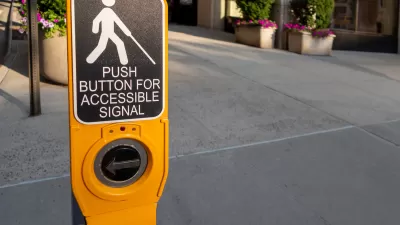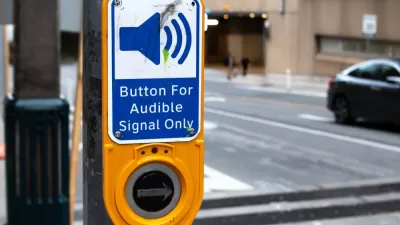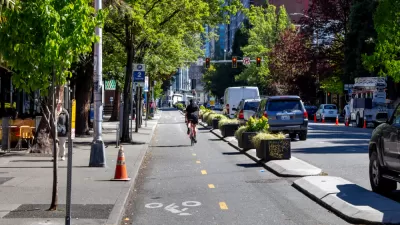Processing a growing backlog of requests, Seattle Department of Transportation must prioritize which intersections will be made accessible.

In Seattle, "the vast majority of pedestrian signals don’t have audible sounds for people who are blind and low vision," reports Heidi Groover, relating the story of a North Seattle resident who is forced to rely on the sound of passing traffic to determine when it's safe to cross the street.
Despite a federal consent decree which requires the installation of more than a thousand curb ramps per year, there's no legislation requiring the addition of Accessible Pedestrian Signals. "More than three quarters of Seattle’s signals do not have such devices," says Groover.
At this point, the Seattle Department of Transportation (SDOT) has a backlog of requests for the installation of accessible signals throughout the city. Even in new intersection construction or alteration projects, replacement of inaccessible signals is not always required, Groover notes. According to Groover, only 22% of pedestrian signals in Seattle are accessible.
One reason for the lack of accessible signals: they're not cheap. "Although SDOT has not produced a formal study of upgrading signals, at $50,000 each, upgrading all 875 crossings without accessible signals would cost about $44 million," writes Groover.
Groover reports that SDOT consults with "an advisory group of people with disabilities to prioritize the requests."
FULL STORY: Many Seattle intersections lack accessible crossing signals for people with vision or hearing loss

Planetizen Federal Action Tracker
A weekly monitor of how Trump’s orders and actions are impacting planners and planning in America.

Chicago’s Ghost Rails
Just beneath the surface of the modern city lie the remnants of its expansive early 20th-century streetcar system.

San Antonio and Austin are Fusing Into one Massive Megaregion
The region spanning the two central Texas cities is growing fast, posing challenges for local infrastructure and water supplies.

Since Zion's Shuttles Went Electric “The Smog is Gone”
Visitors to Zion National Park can enjoy the canyon via the nation’s first fully electric park shuttle system.

Trump Distributing DOT Safety Funds at 1/10 Rate of Biden
Funds for Safe Streets and other transportation safety and equity programs are being held up by administrative reviews and conflicts with the Trump administration’s priorities.

German Cities Subsidize Taxis for Women Amid Wave of Violence
Free or low-cost taxi rides can help women navigate cities more safely, but critics say the programs don't address the root causes of violence against women.
Urban Design for Planners 1: Software Tools
This six-course series explores essential urban design concepts using open source software and equips planners with the tools they need to participate fully in the urban design process.
Planning for Universal Design
Learn the tools for implementing Universal Design in planning regulations.
planning NEXT
Appalachian Highlands Housing Partners
Mpact (founded as Rail~Volution)
City of Camden Redevelopment Agency
City of Astoria
City of Portland
City of Laramie





























